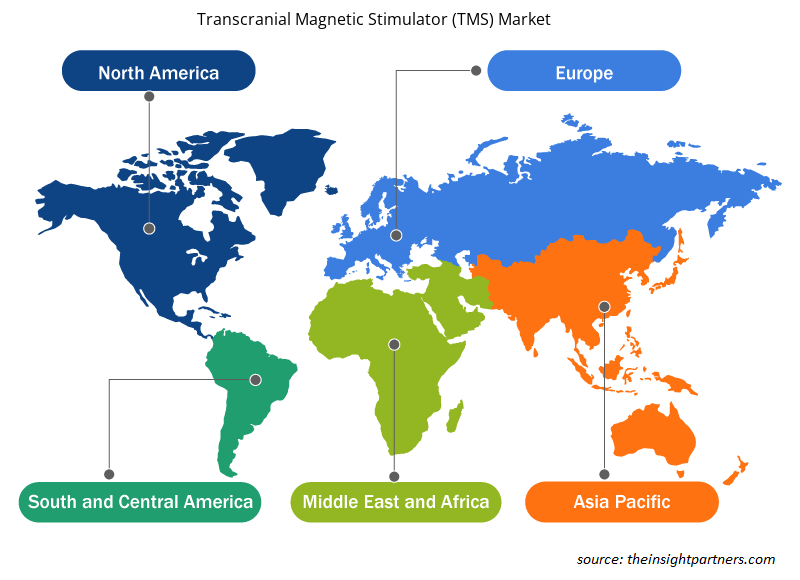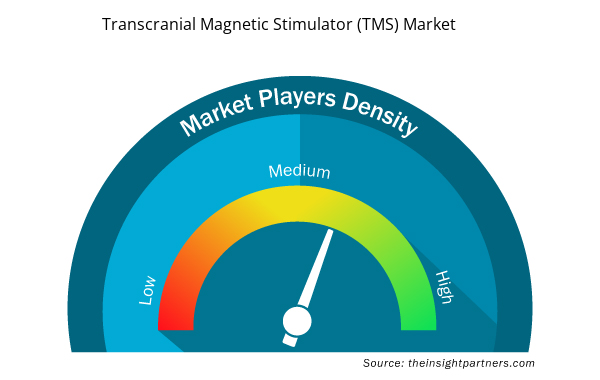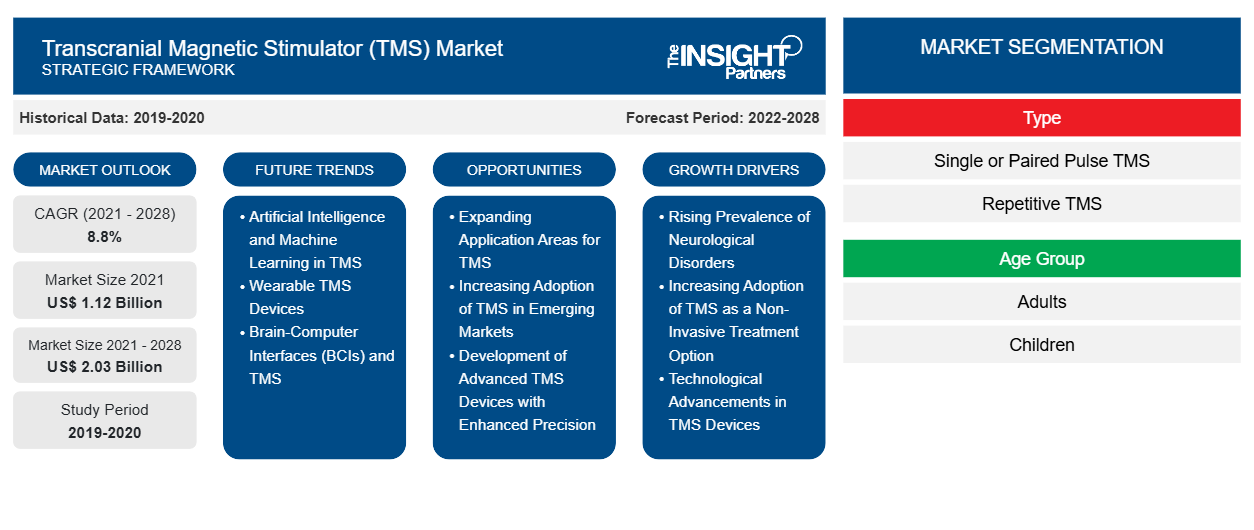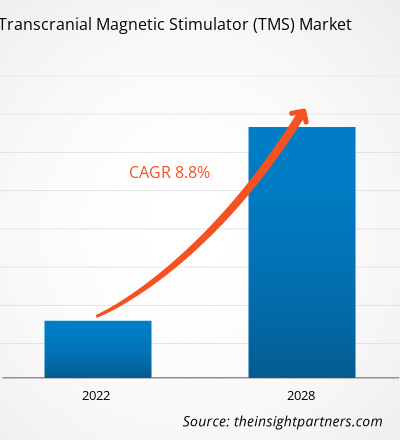[Forschungsbericht] Der Markt für transkranielle Magnetstimulatoren (TMS) soll von 1.122,22 Millionen US-Dollar im Jahr 2021 auf 2.029,71 Millionen US-Dollar im Jahr 2028 anwachsen; von 2021 bis 2028 wird eine durchschnittliche jährliche Wachstumsrate (CAGR) von 8,8 % erwartet.
Neurologische Erkrankungen betreffen das Gehirn und die Nerven des menschlichen Körpers und verursachen unter anderem Epilepsie und Krampfanfälle, Parkinson, Demenz, Autismus, Alzheimer, Hirntumore und Zerebralparese. Die Prävalenz neurologischer Erkrankungen nimmt weltweit zu. Laut der Global Burden of Disease Study (GBD) 2017 waren Alzheimer und andere Demenzerkrankungen [2,55 Millionen behinderungsbereinigte Lebensjahre (DALYs)], Schlaganfall [ca. 3,58 Millionen DALYs] und Migräne (ca. 2,40 Millionen DALYs) die drei belastendsten neurologischen Erkrankungen in den USA, gemessen an der Gesamtzahl der behinderungsbereinigten Lebensjahre.
Darüber hinaus schätzt die Alzheimer's Association, dass über 6 Millionen Amerikaner an Alzheimer leiden, und diese Zahl soll bis 2050 auf fast 13 Millionen ansteigen. Transkranielle Magnetstimulatoren (TMS) werden häufig zur Diagnose und Behandlung neurologischer Störungen eingesetzt. Laut BrainsWay Ltd. wurden beispielsweise im April 2021 weltweit 100.000 Patienten mit dem Deep TMS behandelt. Die zunehmende Verbreitung neurologischer Störungen treibt also das Wachstum des Marktes für transkranielle Magnetstimulatoren (TMS) weltweit voran. Darüber hinaus ist Depression eine der psychischen Störungen, die weltweit häufig auftreten. Laut den im Januar 2020 von der WHO veröffentlichten Daten leiden weltweit mehr als 264 Millionen Menschen aller Altersgruppen an Depressionen.
Passen Sie diesen Bericht Ihren Anforderungen an
Sie erhalten kostenlos individuelle Anpassungen an jedem Bericht, einschließlich Teilen dieses Berichts oder einer Analyse auf Länderebene, eines Excel-Datenpakets sowie tolle Angebote und Rabatte für Start-ups und Universitäten.
- Holen Sie sich die wichtigsten Markttrends aus diesem Bericht.Dieses KOSTENLOSE Beispiel umfasst eine Datenanalyse von Markttrends bis hin zu Schätzungen und Prognosen.
Markteinblicke
Die transkranielle Magnetstimulation (TMS) ist ein nichtinvasives Verfahren zur Behandlung neurologischer Störungen. Darüber hinaus haben die technologischen Entwicklungen im Bereich TMS zu einer Ausweitung seiner Anwendungsmöglichkeiten geführt. Unternehmen, die auf dem Markt für transkranielle Magnetstimulatoren (TMS) tätig sind, verfolgen verschiedene Strategien, wie z. B. die Erlangung von Zulassungen der Food and Drug Administration (FDA) für ihre innovativen Produkte, Geschäftspartnerschaften und die Beschaffung von Mitteln für die Produktentwicklung, die das Marktwachstum vorantreiben.
Nachfolgend einige Beispiele für Entwicklungen:
- Im März 2021 stellte MagVenture den MagVenture Flow Arm vor – ein zum Patent angemeldetes klinisches Positionierungssystem – das die Umsetzung der von der FDA zugelassenen Protokolle von MagVenture für nichtinvasive Hirnstimulationstechnologie zur Behandlung schwerer depressiver Störungen und als Zusatztherapie bei Zwangsstörungen (OCD) optimieren soll.
- Im August 2020 erhielt die MagVenture TMS-Therapie die FDA-Zulassung für die Zusatzbehandlung von Zwangsstörungen. Für das dänische Medizintechnikunternehmen MagVenture ist dies die zweite Indikation in den USA.
- Im Februar 2019 gab eNeura, Inc., ein privates Medizintechnikunternehmen, eine neue 510(k)-Zulassung der FDA bekannt. Mit der Zulassung behauptete das Unternehmen, dass das sTMS das einzige Migräneprodukt in den USA zur Behandlung akuter und prophylaktischer Migränekopfschmerzen bei Erwachsenen und Kindern (ab 12 Jahren) sei.
Daher ist zu erwarten, dass die aktive Beteiligung globaler Akteure an der Entwicklung der transkraniellen Magnetstimulation und verwandter Technologien das Marktwachstum fördern wird.
Typbasierte Erkenntnisse
Basierend auf dem Typ ist der Markt für transkranielle Magnetstimulatoren (TMS) in Einzel- oder Paarpuls-TMS und repetitive TMS (rTMS) segmentiert. Im Jahr 2021 hielt das Einzel- oder Paarpuls-TMS-Segment einen größeren Marktanteil. Es wird jedoch erwartet, dass das Segment repetitive TMS (rTMS) zwischen 2021 und 2028 eine höhere durchschnittliche jährliche Wachstumsrate verzeichnen wird.
Anwendungsbasierte Erkenntnisse
Basierend auf der Anwendung ist der Markt in Forschung, Diagnostik und Therapie segmentiert. Im Jahr 2021 hatte das Diagnostiksegment den größten Marktanteil und wird in den kommenden Jahren voraussichtlich mit der höchsten CAGR wachsen.
Unternehmen, die auf dem Markt für transkranielle Magnetstimulatoren (TMS) tätig sind, legen Wert darauf, die Strategie der Produktinnovation zu verfolgen, um den sich entwickelnden Kundenanforderungen auf der ganzen Welt gerecht zu werden, was es ihnen auch ermöglicht, ihren Markennamen auf dem Weltmarkt zu behaupten.
Umfang des Marktberichts über transkranielle Magnetstimulatoren
Regionale Einblicke in den Markt für transkranielle Magnetstimulatoren (TMS)
Die regionalen Trends und Faktoren, die den Markt für transkranielle Magnetstimulatoren (TMS) während des gesamten Prognosezeitraums beeinflussen, wurden von den Analysten von Insight Partners ausführlich erläutert. In diesem Abschnitt werden auch die Marktsegmente und die Geografie für transkranielle Magnetstimulatoren (TMS) in Nordamerika, Europa, im asiatisch-pazifischen Raum, im Nahen Osten und Afrika sowie in Süd- und Mittelamerika erörtert.

- Erhalten Sie regionale Daten zum Markt für transkranielle Magnetstimulatoren (TMS)
Umfang des Marktberichts zum transkraniellen Magnetstimulator (TMS)
| Berichtsattribut | Details |
|---|---|
| Marktgröße im Jahr 2021 | 1,12 Milliarden US-Dollar |
| Marktgröße bis 2028 | 2,03 Milliarden US-Dollar |
| Globale CAGR (2021 - 2028) | 8,8 % |
| Historische Daten | 2019-2020 |
| Prognosezeitraum | 2022–2028 |
| Abgedeckte Segmente | Nach Typ
|
| Abgedeckte Regionen und Länder | Nordamerika
|
| Marktführer und wichtige Unternehmensprofile |
|
Marktteilnehmerdichte: Der Einfluss auf die Geschäftsdynamik
Der Markt für transkranielle Magnetstimulatoren (TMS) wächst rasant, angetrieben durch die steigende Nachfrage der Endnutzer aufgrund von Faktoren wie sich entwickelnden Verbraucherpräferenzen, technologischen Fortschritten und einem größeren Bewusstsein für die Vorteile des Produkts. Mit steigender Nachfrage erweitern Unternehmen ihr Angebot, entwickeln Innovationen, um die Bedürfnisse der Verbraucher zu erfüllen, und nutzen neue Trends, was das Marktwachstum weiter ankurbelt.
Die Marktteilnehmerdichte bezieht sich auf die Verteilung von Firmen oder Unternehmen, die in einem bestimmten Markt oder einer bestimmten Branche tätig sind. Sie gibt an, wie viele Wettbewerber (Marktteilnehmer) in einem bestimmten Marktraum im Verhältnis zu seiner Größe oder seinem gesamten Marktwert präsent sind.
Die wichtigsten Unternehmen auf dem Markt für transkranielle Magnetstimulatoren (TMS) sind:
- BrainsWay Ltd
- Nexstim
- Magstim
- Neuronetik
- TMS Neuro-Lösungen
Haftungsausschluss : Die oben aufgeführten Unternehmen sind nicht in einer bestimmten Reihenfolge aufgeführt.

- Erhalten Sie einen Überblick über die wichtigsten Akteure auf dem Markt für transkranielle Magnetstimulatoren (TMS)
Markt für transkranielle Magnetstimulatoren (TMS) – Segmentierung
Nach Typ
- Einzel- oder Paarpuls-TMS
- Repetitives TMS (rTMS)
Nach Altersgruppe
- Erwachsene
- Kinder
Nach Anwendung
- Forschung
- Diagnostik
- Therapeutisch
Nach Geografie
- Nordamerika
- UNS
- Kanada
- Mexiko
- Europa
- Frankreich
- Deutschland
- Italien
- Vereinigtes Königreich
- Spanien
- Restliches Europa
- Asien-Pazifik (APAC)
- China
- Indien
- Südkorea
- Japan
- Australien
- Restlicher Asien-Pazifik-Raum
- Naher Osten und Afrika (MEA)
- Südafrika
- Saudi-Arabien
- Vereinigte Arabische Emirate
- Rest von MEA
- Süd- und Mittelamerika (SCAM)
- Brasilien
- Argentinien
- Rest von SCAM
Firmenprofile
- BrainsWay Ltd
- Nexstim, Magstim
- Neuronetik
- TMS Neuro-Lösungen
- MagVenture, Inc.
- eNeura Inc.
- Neurosoft
- MAG & More GmbH
- Historische Analyse (2 Jahre), Basisjahr, Prognose (7 Jahre) mit CAGR
- PEST- und SWOT-Analyse
- Marktgröße Wert/Volumen – Global, Regional, Land
- Branche und Wettbewerbsumfeld
- Excel-Datensatz



Report Coverage
Revenue forecast, Company Analysis, Industry landscape, Growth factors, and Trends

Segment Covered
This text is related
to segments covered.

Regional Scope
North America, Europe, Asia Pacific, Middle East & Africa, South & Central America

Country Scope
This text is related
to country scope.
Häufig gestellte Fragen
Asia Pacific is expected to be the fastest-growing region and is likely to expand at a high growth rate due to large geriatric population, rising numbers of neurological disorders are among the factors expected to drive the market in the region during the forecast period.
The global Transcranial Magnetic Stimulator (TMS) market based on type is segmented into Single or paired pulse TMS and Repetitive TMS (rTMS). In 2021, the Single or paired pulse TMS segment held the largest share of the market, by type. The Repetitive TMS (rTMS) segment of Transcranial Magnetic Stimulator (TMS) market is also expected to witness fastest CAGR during 2021 to 2028..
The Transcranial Magnetic Stimulator (TMS) market majorly consists of the players such as BrainsWay Ltd, Nexstim, Magstim, Neuronetics, TMS Neuro Solutions, MagVenture, Inc., eNeura Inc., Neurosoft, MAG & More GmbH. REMED among others amongst others.
The US is the largest market for Transcranial Magnetic Stimulator (TMS) at a global level. The US is the largest and fastest-growing market for the TMS market. The market growth is attributed to increasing developments of the medical device sector for neuromodulation, significantly rising incidences of neurological disorders among people and growing demand for neuromodulation devices for chronic pain management. In addition, the economic burden to treat neurological disorders is significantly growing in the country. For instance, according to a study published by the American Neurological Association in March 2017, ~US$ 800 billion is spent per year for treating neurological disorders. The cost of treatment affects ~100 million people every year across the country. It is also estimated that the treatment cost of dementia and stroke alone is estimated to reach over US$ 600 billion in 2030.
The factors that are driving and restraining factors that will affect Transcranial Magnetic Stimulator (TMS) market in the coming years. Factors such as rising prevalence of neurological disorders, growing developments in transcranial magnetic stimulation technology are driving the market growth. However, high cost of diagnostic and treatment are likely to hamper the growth of the market.
Transcranial Magnetic Stimulator (TMS), also referred to us repetitive Transcranial Magnetic Stimulator (rTMS), is a type of brain stimulation in which a changing magnetic field is applied to a specific area of the brain. An electric pulse stimulator is attached to a magnetic coil, which is then connected to the scalp. It is a non-invasive procedure and is used for diagnostic and therapeutic applications.
Trends and growth analysis reports related to Life Sciences : READ MORE..
The List of Companies - Transcranial Magnetic Stimulator (TMS) Market
- BrainsWay Ltd
- Nexstim
- Magstim
- Neuronetics
- TMS Neuro Solutions
- MagVenture, Inc.
- eNeura Inc.
- Neurosoft
- MAG & More GmbH.
- REMED
The Insight Partners performs research in 4 major stages: Data Collection & Secondary Research, Primary Research, Data Analysis and Data Triangulation & Final Review.
- Data Collection and Secondary Research:
As a market research and consulting firm operating from a decade, we have published and advised several client across the globe. First step for any study will start with an assessment of currently available data and insights from existing reports. Further, historical and current market information is collected from Investor Presentations, Annual Reports, SEC Filings, etc., and other information related to company’s performance and market positioning are gathered from Paid Databases (Factiva, Hoovers, and Reuters) and various other publications available in public domain.
Several associations trade associates, technical forums, institutes, societies and organization are accessed to gain technical as well as market related insights through their publications such as research papers, blogs and press releases related to the studies are referred to get cues about the market. Further, white papers, journals, magazines, and other news articles published in last 3 years are scrutinized and analyzed to understand the current market trends.
- Primary Research:
The primarily interview analysis comprise of data obtained from industry participants interview and answers to survey questions gathered by in-house primary team.
For primary research, interviews are conducted with industry experts/CEOs/Marketing Managers/VPs/Subject Matter Experts from both demand and supply side to get a 360-degree view of the market. The primary team conducts several interviews based on the complexity of the markets to understand the various market trends and dynamics which makes research more credible and precise.
A typical research interview fulfils the following functions:
- Provides first-hand information on the market size, market trends, growth trends, competitive landscape, and outlook
- Validates and strengthens in-house secondary research findings
- Develops the analysis team’s expertise and market understanding
Primary research involves email interactions and telephone interviews for each market, category, segment, and sub-segment across geographies. The participants who typically take part in such a process include, but are not limited to:
- Industry participants: VPs, business development managers, market intelligence managers and national sales managers
- Outside experts: Valuation experts, research analysts and key opinion leaders specializing in the electronics and semiconductor industry.
Below is the breakup of our primary respondents by company, designation, and region:

Once we receive the confirmation from primary research sources or primary respondents, we finalize the base year market estimation and forecast the data as per the macroeconomic and microeconomic factors assessed during data collection.
- Data Analysis:
Once data is validated through both secondary as well as primary respondents, we finalize the market estimations by hypothesis formulation and factor analysis at regional and country level.
- Macro-Economic Factor Analysis:
We analyse macroeconomic indicators such the gross domestic product (GDP), increase in the demand for goods and services across industries, technological advancement, regional economic growth, governmental policies, the influence of COVID-19, PEST analysis, and other aspects. This analysis aids in setting benchmarks for various nations/regions and approximating market splits. Additionally, the general trend of the aforementioned components aid in determining the market's development possibilities.
- Country Level Data:
Various factors that are especially aligned to the country are taken into account to determine the market size for a certain area and country, including the presence of vendors, such as headquarters and offices, the country's GDP, demand patterns, and industry growth. To comprehend the market dynamics for the nation, a number of growth variables, inhibitors, application areas, and current market trends are researched. The aforementioned elements aid in determining the country's overall market's growth potential.
- Company Profile:
The “Table of Contents” is formulated by listing and analyzing more than 25 - 30 companies operating in the market ecosystem across geographies. However, we profile only 10 companies as a standard practice in our syndicate reports. These 10 companies comprise leading, emerging, and regional players. Nonetheless, our analysis is not restricted to the 10 listed companies, we also analyze other companies present in the market to develop a holistic view and understand the prevailing trends. The “Company Profiles” section in the report covers key facts, business description, products & services, financial information, SWOT analysis, and key developments. The financial information presented is extracted from the annual reports and official documents of the publicly listed companies. Upon collecting the information for the sections of respective companies, we verify them via various primary sources and then compile the data in respective company profiles. The company level information helps us in deriving the base number as well as in forecasting the market size.
- Developing Base Number:
Aggregation of sales statistics (2020-2022) and macro-economic factor, and other secondary and primary research insights are utilized to arrive at base number and related market shares for 2022. The data gaps are identified in this step and relevant market data is analyzed, collected from paid primary interviews or databases. On finalizing the base year market size, forecasts are developed on the basis of macro-economic, industry and market growth factors and company level analysis.
- Data Triangulation and Final Review:
The market findings and base year market size calculations are validated from supply as well as demand side. Demand side validations are based on macro-economic factor analysis and benchmarks for respective regions and countries. In case of supply side validations, revenues of major companies are estimated (in case not available) based on industry benchmark, approximate number of employees, product portfolio, and primary interviews revenues are gathered. Further revenue from target product/service segment is assessed to avoid overshooting of market statistics. In case of heavy deviations between supply and demand side values, all thes steps are repeated to achieve synchronization.
We follow an iterative model, wherein we share our research findings with Subject Matter Experts (SME’s) and Key Opinion Leaders (KOLs) until consensus view of the market is not formulated – this model negates any drastic deviation in the opinions of experts. Only validated and universally acceptable research findings are quoted in our reports.
We have important check points that we use to validate our research findings – which we call – data triangulation, where we validate the information, we generate from secondary sources with primary interviews and then we re-validate with our internal data bases and Subject matter experts. This comprehensive model enables us to deliver high quality, reliable data in shortest possible time.


 Holen Sie sich ein kostenloses Muster für diesen Bericht
Holen Sie sich ein kostenloses Muster für diesen Bericht